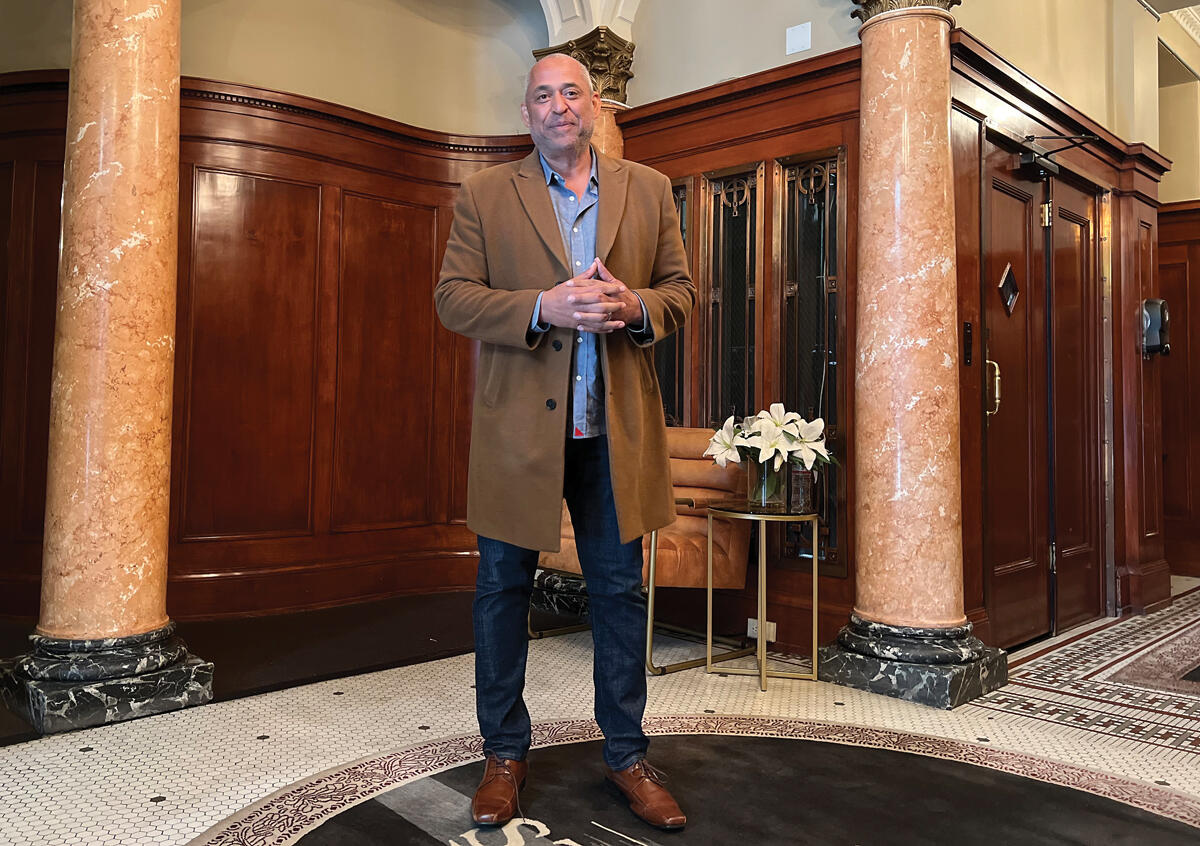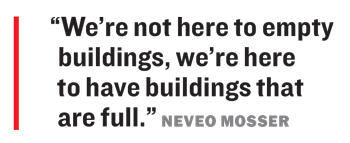Trending
After investor-fueled growth, Mosser Capital says it’s still guided by founder’s vision
San Francisco's long-haul landlord evolves from a family business to one of the city's top multifamily players

Call Mosser Companies big, but don’t call Neveo Mosser a big shot.
The middle-income housing specialist has spent the past decade using an infusion of institutional investment to evolve from a family-run business that owned and managed about 40 San Francisco apartment buildings into one of the city’s biggest multifamily landlords, now with more than twice that many properties from its hometown to Oakland and Los Angeles.
The growth spurt has been backed by Wall Street as well as sovereign wealth funds from around the globe, but Neveo Mosser balks at any notion that the company his father, Charles, founded nearly 70 years ago has gone corporate.
“We never really think of ourselves as a big player — we look at it as we’re a working-class family with deep roots in the communities that we work in and live in,” said Mosser, CEO of Mosser Companies and chair of its investment arm, Mosser Capital.
Mosser co-owns the family business along with his sister, Deborah, whose son-in-law Jim Farris runs Mosser Capital’s day-to-day operations as CEO.
The small-potatoes sentiment Neveo Mosser expresses seems genuine, but it’s also pragmatic: In the regulated markets in which Mosser operates — many of the units in its portfolio are rent-controlled — landlords of all sizes frequently feel as though they are under fire, and larger players in particular tend to invite unwanted attention.
Mosser Companies has gotten large, in any case. The company now has about 5,000 tenants across around 3,000 occupied units, according to COO Andrew Silverman. The firm specializes in what Silverman called “affordable by design” apartments: studios and one bedrooms in less-expensive areas, primarily in rent-controlled buildings. He said the company is pleased that its units in San Francisco generally rent for about $1,000 less than the average $3,000 a month for a one-bedroom in the city.
“Not the sexy stuff”
Mosser Companies has made a market of apartments affordable to renters who aren’t pulling in six-figure incomes from the Bay Area’s tech industry.
“Our job is to make sure we do a great job looking after those properties, even though it’s not the sexy, shiny glass tower stuff that so many people focus on,” Silverman said.
Investing in unsexy older properties in need of capital improvements and then holding onto them for the long term has proven a winning strategy for Mosser Companies since its start. The company doubled down on the concept when it began taking outside investment in 2011, when Farris came onboard as CEO of Mosser Capital after nearly a decade in the mortgage industry.
Neveo Mosser recalls the transition from a family-owned and run company to an institutionally funded one as the subject of much discussion among the family after his father’s death in 2007.
But once it launched, it quickly took off.
 Mosser Capital now holds $1.5 billion in assets under management, according to publicly released company figures.
Mosser Capital now holds $1.5 billion in assets under management, according to publicly released company figures.
Three-quarters of Mosser’s buildings are in San Francisco. The rest are split between Oakland and L.A., where it spent $46 million for the nearly 200-unit Wilshire Royale apartments at the end of last year. The company is now raising a $100 million “workforce housing fund focused on preserving high-quality affordable and middle-income housing opportunities in California,” Farris wrote in an email.
The firm does not reveal its investors, but Farris said that they include “sovereign wealth funds, global insurance companies, U.S.-based endowments, domestic and foreign family offices and foundations.” SEC filings show prior connections to Blue Mountain Capital, a New York-based hedge fund now known as Assured Investment Management, and GIC, a Singaporean sovereign wealth fund with a history of investing in American real estate.
No pandemic pause
San Francisco rents dropped precipitously and vacancies skyrocketed after strict shelter-in-place rules began in March 2020, but Mosser did not take the same pandemic pause that many other established multifamily buyers in the city did. The firm was one of the first players to get off the sidelines after apartment sales slowed to a near standstill in the second half of 2020 and early 2021, according to multifamily agents.
“They’re definitely getting bigger,” said Allison Chapleau of Vanguard Commercial, who added that she expects the company’s appetite for apartments to endure. “When I talk to them about properties, they’re thinking about the future.”
The company also rarely parts with properties once it buys them, a philosophy that came directly from its eccentric founder, whose 2007 obituary includes references to his poor beginnings in the foothills of the Sierra Nevada, military service in the Pacific theater during World War II, a strict raw food diet, five marriages, an honorary chiefdom of an Indigenous tribe in the Philippines, where he held honorary citizenship, and a “knack for spotting distressed, mismanaged properties needing attention that he snapped up, sunk capital into, and held onto for the long haul.”
The company still owns the Lower Haight apartments Charles Mosser bought as one of his first big multifamily investments in 1978, when he decided there was more money to be made in buying and running apartment buildings than sticking with his job as owner of a real estate agency.
Despite Neveo Mosser’s protests to the contrary, Mosser is a big owner in a city where many apartment buildings are owned by individuals and family-run operations.
And its size has brought scrutiny. During the pandemic, Mosser Companies took heat for going after limited PPP and rent relief funds that some San Francisco supervisors and tenant groups argued were meant for smaller businesses.
Neveo said the PPP loans allowed him to keep his approximately 260 staffers, some of whom have been with the company for decades, “fully employed” and permitted his in-house maintenance staff to perform the type of “enhanced janitorial work” that was both required and made more difficult and expensive by the pandemic. At one point, the company even tried making its own hand sanitizer when supplies were running low, he said. Plus, as he pointed out, some of his buildings had a 30 percent vacancy rate during the depths of the pandemic, and up to 40 percent of the firm’s remaining tenants weren’t paying rent.

1060 Bush Street, a 75-unit Mosser apartment building in San Francisco
“I think we were one of the few industries that were asked to do more, but not to be reimbursed for it,” he said, accusing “disingenuous” tenant groups of asking residents to take on unnecessary debt by rejecting federal rent relief funds “solely for a political purpose.”
Mosser brought in the Tenderloin Housing Clinic, a tenants’ rights organization and longtime partner, to help its residents sign up for rent relief funds. Randy Shaw, the THC’s executive director, recalled meeting Mosser in the mid-1990s, when the pair worked together on an adopt-a-block program designed to keep drug dealers out of apartment buildings in the downtown neighborhood, which is still fighting similar quality-of-life battles.
“He owned much less property at the time and was primarily focused on improving the Tenderloin,” Shaw said. “He has always been a great ally to the neighborhood.”
Shaw said he hasn’t seen a change in Mosser himself since his company took on institutional investment, but said via email that “as a general rule when any organization grows there can be more issues with problem staff, poor on-site decisions, etc.” Shaw said he had never heard of Mosser pushing out below-market tenants, but added that his knowledge of the firm’s practices was limited to the Tenderloin.
“Robber baron” or “enlightened capitalism”?
Across the bay in Oakland, tenant displacement and harassment are precisely what Mosser is being accused of, according to Leah Simon-Weisberg, legal director of the Alliance of Californians for Community Empowerment, which brought five suits against the company last year on behalf of 40 tenants.
In contrast to Shaw’s assessment in San Francisco, Simon-Weisberg called Mosser a “robber baron” and said the company’s long-established local roots do not counter the argument that its business model is “based on lots of illegal strategies to basically pump up rents.” The lawsuits accuse Mosser Companies of improper billing, unscheduled visits to tenants’ units and general neglect, among other things.
“Being from the Bay Area is not good enough,” she said. “Their investors are from all over the planet, so that’s just nonsense.”
No one at Mosser Companies would comment on the lawsuits, as they are still being litigated. Generally speaking, Neveo Mosser said, displacement is the opposite of what he called the company’s “enlightened capitalism” philosophy.
“We’re not here to empty buildings, we’re here to have buildings that are full,” he said.
Silverman, the company’s COO, said its current renters have been in their units for an average of 10 years and that Neveo Mosser knows many long-term tenants by name. In the early days of the pandemic, Silverman said, the CEO requested that staff deliver toilet paper and canned goods to tenants so they didn’t need to risk leaving home.
“I’ve been in real estate and construction for 30 years,” Silverman said. “That’s a level of intimacy you don’t see.”
Mixing it up
As a person of color in a position of power in the real estate industry, Mosser, who is African-American, said he is sensitive to the concerns of the communities in which his company operates and rents out ground-floor retail space accordingly, even if it occasionally means accepting a lower-paying commercial tenant — a lesson he says he took from his father.
But he also believes that neighborhoods “from Tiburon to the Tenderloin” are not served best by a “monocultural” community where everyone has the same “economic stature,” and that the boutiques and barbershops in his buildings need neighbors with disposable income in order to survive.
“We’re not putting a Prada store or a Gump’s into this area,” he said, referring to the luxury home furnishings retailer. “We’re giving young, first-time entrepreneurs the ability to get established in the communities they want to operate in with responsible businesses … I think for a while, pre-pandemic, the Tenderloin was thriving. You had younger tech kids or people that were working in hotels next to people that were on government assistance.”
Though the Tenderloin, like the city at large, was hit hard during the pandemic by high vacancy rates at both residential and commercial properties, some now see a light at the end of the tunnel that would reward the investment risks Mosser took at the time. In May, the companies’ buildings were 87 percent full, Silverman said, compared to 75 percent a year earlier. That’s still lower than San Francisco’s citywide pre-pandemic occupancy rate of about 96 percent, but high enough to draw the attention of potential new investors, according to CEO Farris.
“There is significant pent-up investor interest in investing in workforce and affordable housing in a market that continues to have a large supply-and-demand imbalance,” Farris said.
Mosser said his father has appeared in his dreams recently. He believes the elder Mosser would be “surprised” and “proud” by what his namesake company has become and the fact that his children and grandchildren are still involved in it.
“There’s always a sense of strength when he’s in my dreams,” he said.
Neveo Mosser also figures that the financial backing of the institutional investors that the family brought on after much internal debate is likely what has allowed them to find opportunities when some of the city’s other “third- or second-generation [apartment owners] just want to throw up their hands.”
“They can’t make it through because they don’t have the ability to pay their mortgage or expenses, or it’s just too much of a headache operating,” he said. “And so that provides some opportunities for us to continue to grow.”




